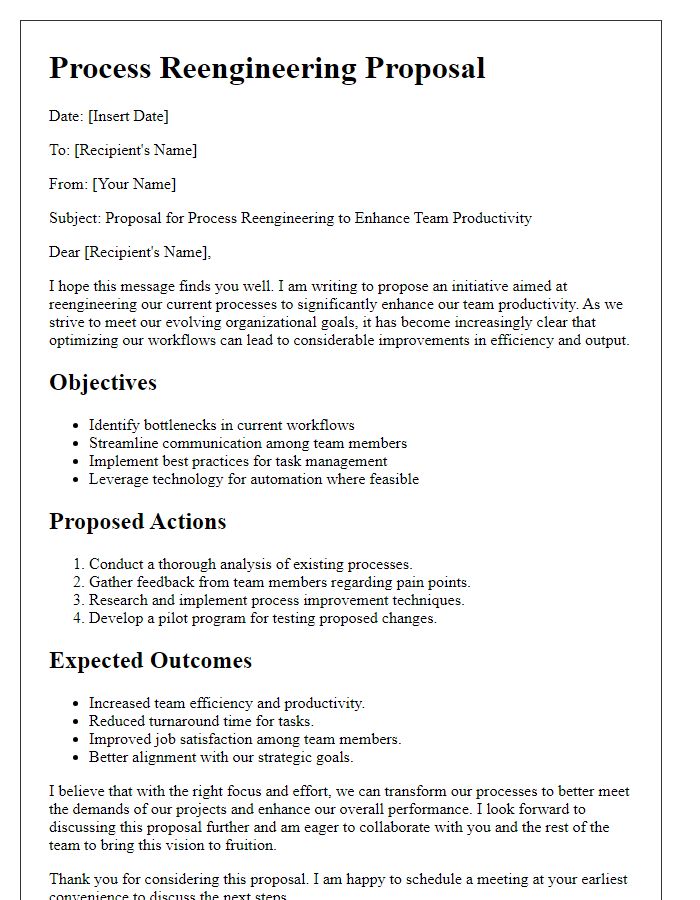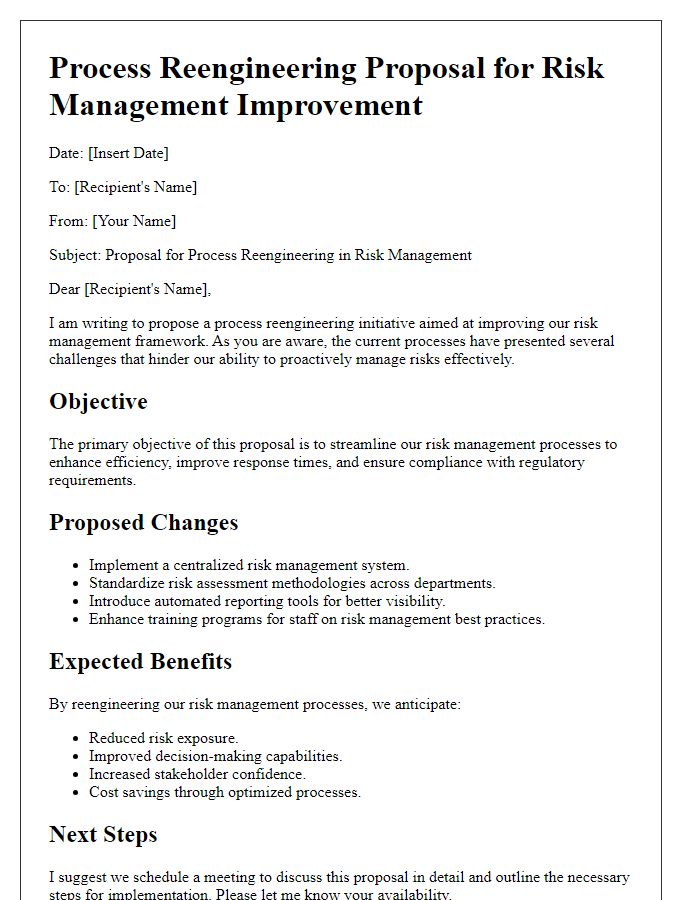Are you looking to revamp your organization's processes for greater efficiency and productivity? In this article, we'll explore a comprehensive letter template designed specifically for proposing process reengineering initiatives. By outlining clear objectives and benefits, this proposal will help you communicate your vision effectively to stakeholders. So, let's dive into the details and discover how you can transform your operational landscape!

Purpose and Objectives
The purpose of process reengineering is to fundamentally rethink and redesign business processes to achieve significant improvements in critical measures of performance, such as cost, quality, service, and speed. This transformative initiative aims to eliminate inefficiencies, streamline workflows, and enhance collaboration among departments, ultimately leading to increased customer satisfaction and competitiveness in the industry. Objectives include identifying bottlenecks within existing processes, leveraging technology solutions such as automation tools, and fostering a culture of continuous improvement through employee engagement and feedback mechanisms. By focusing on these goals, organizations can create a more adaptive and resilient operational framework that aligns with evolving market demands.
Current Process Analysis
Current process analysis in organizations identifies inefficiencies and bottlenecks. Workflow mapping techniques highlight steps taken in processes, indicating areas of delay or redundancy. Data collection methods, such as surveys, interviews, and observation, offer insights into employee experiences and challenges faced during task execution. Key performance indicators (KPIs), including cycle time, cost per transaction, and error rates, provide quantitative measures reflecting process effectiveness. Stakeholder feedback, particularly from team members directly involved in the process, can uncover hidden issues and potential improvements. Tools such as SWOT analysis (Strengths, Weaknesses, Opportunities, Threats) further illuminate opportunities for enhancement, guiding a structured approach toward reengineering efforts.
Proposed Changes and Improvements
Process reengineering involves a systematic approach to analyzing and redesigning workflows and processes within an organization to enhance efficiency and productivity. A detailed examination of current workflows, such as customer service operations in financial institutions, reveals bottlenecks that can lead to customer dissatisfaction. Implementing automation technologies, with tools like Robotic Process Automation (RPA), can streamline repetitive tasks and reduce processing times, which currently exceed 5 days for loan applications. Additionally, adopting Lean methodologies can help eliminate wasteful activities, potentially improving turnaround times by up to 30%. By integrating data analytics tools, decision-making can be data-driven, leading to informed strategies that align with industry benchmarks, enhancing overall organizational performance.
Benefits and Expected Outcomes
A process reengineering proposal focuses on improving efficiency in organizational workflows, aiming for significant enhancements in performance metrics. By analyzing current processes, inefficiencies can be identified, leading to innovations in method execution. Expected outcomes may include reduced operational costs, potentially decreasing expenditures by up to 30%, improved customer satisfaction rates, resulting in an increase of at least 20% in repeat business, and faster processing times that optimize resource allocation. Additional benefits encompass streamlined communication among teams, enhanced data accuracy, and improved employee morale due to reduced repetitive tasks. Implementing these changes could lead to a measurable ROI within six months post-implementation, contributing to long-term strategic goals and sustainability within the industry.
Implementation Plan and Timeline
The process reengineering proposal outlines a comprehensive implementation plan aimed at optimizing workflows within the organization. The plan includes key phases such as assessment (conducted over a four-week period beginning December 1, 2023, at the headquarters in Atlanta, Georgia), design (spanning six weeks to create new models), and implementation (projected for February 2024). Each phase is accompanied by specific milestones, including stakeholder meetings and prototype testing, ensuring that both engagement and feedback are integrated into the redesign. A detailed timeline will track progress and facilitate accountability, utilizing project management tools like Gantt charts to visualize the workflow. Critical resources such as specialized software, training workshops, and team personnel from various departments will also be allocated, ensuring the necessary support for a smooth transition. Regular reviews will occur bi-weekly, to assess progress against benchmarks and allow for necessary adjustments.
Letter Template For Process Reengineering Proposal Samples
Letter template of process reengineering proposal for enhancing operational efficiency.

Letter template of process reengineering proposal focused on cost reduction strategies.

Letter template of process reengineering proposal aimed at improving customer satisfaction.

Letter template of process reengineering proposal for streamlining workflows.

Letter template of process reengineering proposal designed to integrate new technologies.

Letter template of process reengineering proposal targeting cross-functional collaboration.

Letter template of process reengineering proposal to boost team productivity.

Letter template of process reengineering proposal for risk management improvement.

Letter template of process reengineering proposal intended for compliance enhancement.





Comments